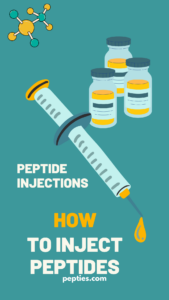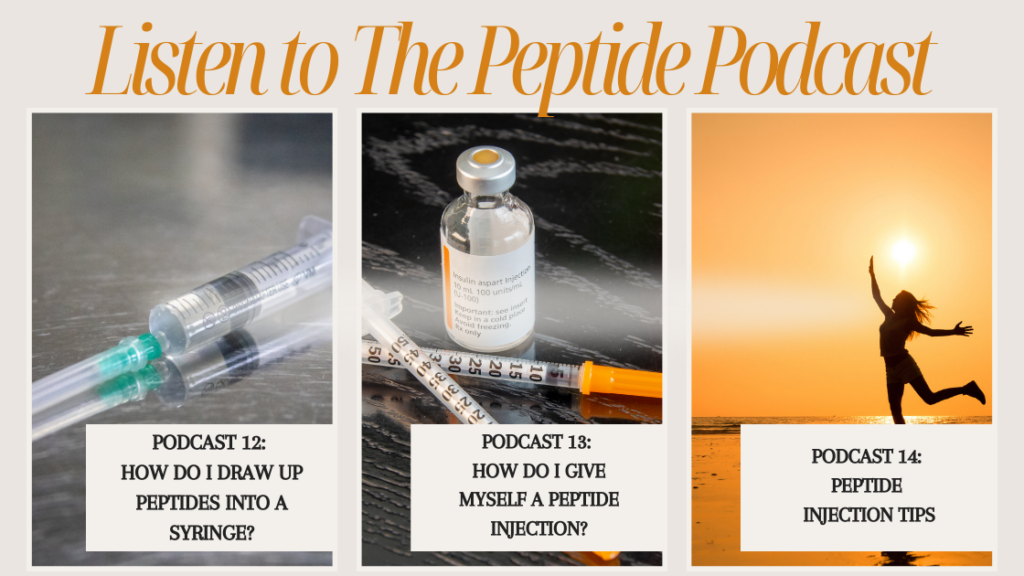Estimated reading time: 5 minutes
Peptides can treat many conditions. They may improve recovery from injury and wound healing and decrease joint and muscle pain. Peptides are often used in skin care to help repair, hydrate, and calm your skin. They are also used to help decrease inflammation, improve sex drive, and enhance memory.

When it comes to peptide injections, subcutaneous (under the skin) or intramuscular (into the muscle) injections are the most effective. This is because peptides are easily broken down and destroyed by your stomach enzymes. This means that if you take most peptides orally (by mouth), you may lose most of their benefits because the peptides will be destroyed before they can reach your bloodstream.
In the beginning, giving yourself a peptide injection at home may seem confusing or difficult. But with some practice, giving yourself a peptide injection can be quick and easy. Let’s take a look at the different types of injections used to give peptide injections and how to best give them to yourself.
How do you give subcutaneous and intramuscular injections?
Intramuscular injections are given into a muscle that has a blood supply. This allows peptides to be absorbed faster than they would be by the subcutaneous route. Intramuscular injections require a needle around 1 inch long for most adults. The correct needle length is determined by the patient’s size, age, and the amount of fat tissue in the chosen injection site. This length allows the peptides to pass through the different skin and fat layers but not too long to risk hitting underlying nerves and bone.
The thickness of the needle is measured in millimeters and is referred to as the “gauge .” Needle gauges for intramuscular injections typically range between 22 and 25 gauges. A good way to remember needle width is the higher the gauge number, the finer or thinner the needle.
Intramuscular peptide injections should be given so that the needle enters your body at a 90-degree angle. This means it should be a straight injection, not at an angle. Intramuscular injections are given in the outside of the upper arm, in the hip, in the buttocks, or in the thigh.
Subcutaneous injections aren’t injected as deep as intramuscular injections. These injections are given in the layer of fat between your skin and muscle. This area is not as richly supplied with blood vessels as are your muscles. Peptides given by the subcutaneous route are absorbed more slowly than with intramuscular injections.
Subcutaneous peptide injections require a thinner, shorter needle. Needle gauges for subcutaneous injections typically range between 25 and 31 gauge with needle lengths around ¼ inch to ½ inch long.
The needle length and needle insertion angle depend on a person’s weight and amount of subcutaneous tissue. Subcutaneous injections can be given so that the needle enters your body at a 45 or 90-degree angle. The needle can be inserted at a 90-degree angle across pinched skin for people with a significant amount of fatty tissue. For those with minimal fatty tissue, the needle should be inserted at a 45-degree angle across pinched skin.
Subcutaneous injections are given in the back of the upper arm, in your stomach, or in the thigh. Whether you’re giving yourself intramuscular or subcutaneous injection, it’s best to alternate where you inject your peptides with each dose. Try to avoid giving yourself an injection in the same place twice in a row.
Talk to your healthcare provider or pharmacist about which needle length and gauge will work best for your peptide injections.
How do I draw up the peptides into the syringe?
Before giving yourself a peptide injection, gather all the supplies you’ll need. This may include syringes, needles, alcohol pads, and a sharps container (a hard, plastic container that stores used needles and syringes). Here’s a list of steps to follow:
- Wash your hands.
- Check your medication. Make sure the medication name on the vial matches the medication name on the prescription label. Make sure the medication isn’t expired.
- If this is your first time using the vial, remove the plastic top. Throw the plastic top away. A rubber stopper will be under the plastic top. Clean the rubber stopper with an alcohol pad.
- Keeping the syringe cap on the needle, pull back the plunger on the syringe to add the same amount of air as the dose of your peptide injection into the syringe. For example, if you’re injecting 0.25 mL of Ipamorelin/ CJC 1295, fill the syringe with 0.25 mL of air.
- Remove the cap from the needle. Insert the needle into the top of the vial and inject the air. This added air will make it easier to remove the peptides from the vial. Leave the needle in the vial.
- Hold the vial with one hand and the syringe with the other hand. Turn the vial and syringe upside down, and draw out the amount needed for your dose. If you accidentally draw up too much, gently push on the plunger to push the liquid back into the vial.
- With the needle still in the vial, check for air bubbles inside the syringe. If you see air bubbles, gently tap on the side of the syringe to make the air bubbles rise to the top. Slowly push on the plunger to push the air bubbles into the vial.
- Remove the needle from the vial.
You’re now ready to inject your peptides.
– – –
References
Centers for Disease Control and Prevention. (2022). Vaccine Administration.
Centers for Disease Control and Prevention. (2020). Vaccine administration: Needle gauge and length.
Review All References
Kovalainen, M., et al. (2015). Novel delivery systems for improving the clinical use of peptides. Pharmacological Reviews.
MedlinePlus. (2020). Drawing medicine out of a vial. National Library of Medicine.
MedlinePlus. (2020). Giving an IM (intramuscular) injection. National Library of Medicine.
MedlinePlus. (2019). Subcutaneous (SQ) injections. National Library of Medicine.
Minnesota Department of Health. (2019). Needle gauge resource list.
National Institutes of Health. (2012). Patient education. Giving a subcutaneous injection.
The University of Texas at Austin. (n.d.). Sharps safety.
Usach, I., et al. (2019). Subcutaneous injection of drugs: Literature review of factors influencing pain sensation at the injection site. Advances in Therapy.
U.S. Food & Drug Administration. (2021). Sharps disposal containers.
How GLP-1 Agonists May Improve NASH
Have you heard of fatty liver disease? Well, fatty liver disease is just what it sounds like—it’s when fat builds up in the liver and starts causing issues. The official name for it is “nonalcoholic fatty liver disease,” or NAFLD for short. Now, if that fat buildup leads to inflammation, it’s called “nonalcoholic steatohepatitis,” or…
Switching From Semaglutide to Tirzepatide
Someone might switch from semaglutide to tirzepatide to achieve greater weight loss or improve blood sugar control. Tirzepatide has been shown to be more effective for some people because it works on two different hormones, GLP-1 and GIP. This combination can lead to better results in managing weight and overall health. Additionally, if a person…


I’ve been looking for a place in Illinois that does intramuscular peptide injections but cannot find any.
Any help you can offer?
Great question. It’s difficult to find clinics that will offer intramuscular (IM) peptide injections for certain peptides. IM injections are great because they are absorbed faster than subcutaneous (SC) injections. This is because there is a greater blood supply than the fatty tissue under your skin. Muscle tissue can also hold a larger volume of medication than fatty tissue. However, certain peptides like CJC 1295 and Ipamorelin require a much slower absorption rate. This is why they are given by SC injection.
There are clinics that will administer peptides intravenously (IV)- into your vein. Raden Wellness in Chicago offers Cerebrolysin, TA1 and TB4, both IV and SC. Renew Vitality Testosterone Clinic in Chicago offers BPC 157 by IM route. This is a great option if you have a sports or exercise-realted injury.
Do all injectables require the use of bacteriostatic water? If so, how much per shot? If not, how do you know which ones do need it?
Hello Mike! It depends. You need to understand if the injectable you’re using is a single-dose vial (using one time) or a multi-dose vial (using many times).
If you are using a single-dose vial, either can be used. If you are using a multi-dose vial, you should use bacteriostatic water to dilute your medication/peptide.
This is because bacteriostatic water contains 0.9% benzyl alcohol. This is added to ensure that bacteria do not grow in the water for up to 28 days.
Sterile water, on the other hand, doesn’t have anything added to prevent bacteria from growing. This is why you should only use it to dilute single-dose vial medications/peptides. It should be used completely at once and then thrown away.
I hope this helps!
I want to use IGF-1. Multi-dose. How do I find out how to reconstitute the peptide? I’ve been told i need to use acetic acid over BAC water.
Also is IGF-1 more effective intramuscular or SUBQ?
Thanks.
Pt-141 how do you feel about it and how should it be injected and in what area I’ve been using it I just want to make sure I’m doing it right
Hello Jeff! PT-141 has shown great results in helping with sexual desire. The most common side effects are nausea, flushing, injection site reactions, headache, and vomiting. So don’t use PT-141 if you have high blood pressure or heart disease. To answer your question about how it should be injected and what areas it can be injected into. PT-141 can be injected into the fatty tissue of your stomach or upper thighs 30 minutes to 6 hours before sexual activity. You should not use more than 1 dose of PT-141 in 24 hours or more than 8 doses of PT-141 within a month. I hope this helps.
Hi I’m looking to use bpc- 157 to help with a rotator cuff injury what you recommend for injection. Thanks
Hello Jay. Typically for an acute injury such as a torn rotator cuff, BPC-157 can be given by injection under the skin (subcutaneous injection) daily for 6 to 12 weeks, with a one month break to follow. The dose is typically 400 to 600 mcg daily. Because BPC-157 acts systemically, the injection can be given anywhere into the fatty tissue (e.g., stomach, tops of thighs, back of upper arm). There are some people who inject BPC-157 directly around the site of injury.
I hope this helps!
Hey I’m about do to BPC-157 and TB-500 Blend. Ordered 3 10 mg vials what’s ur recommendation on the dosages? I don’t want just minimum but also don’t want max want right in middle or little more.
Hello Paul! Are you using this for a specific injury (acute or chronic)?
It would be acute on rotator cuff and chronic pain at the very bottom of spine when I’m in certain positions messed it up dead lifting at the gym
Also just got the stuff today and the vial says 10mg blend BPC-157 5mg and TB-500 5mg
Typically the dose for BPC-157/TB500 blend is 300 MICROGRAMS subcutaneously twice daily for 6 weeks. Then 6 weeks off (hold medication).
I have an rotator cuff injury and am 185 pounds hoe much tb-500 and Bpc-157 should I use of each.
BPC-157- depending on the severity of the rotator cuff injury, inject 2.5mcg/kg to 3.75mcg/kg subcutaneously twice daily for up to 12 weeks then one month off.
TB500 – inject 300 mcg twice daily up to 12 weeks, then 6 weeks off.
I have small itchy bumps at AOD 9604 injection site. What causes that and is there a way to avoid it?
Hello! Sorry you are dealing with this.
Small itchy bumps at an injection site can result from either irritant or immune-mediated reactions:
Irritant Reaction: This type of reaction occurs due to direct irritation from the injection itself or the substance injected. It typically causes localized redness, itching, and sometimes swelling. The irritation can be due to the physical trauma of the needle or the chemical nature of the injected substance.
Immune-Mediated Reaction: This involves the immune system’s response to the injected substance. It can manifest as an allergic reaction or hypersensitivity, leading to small itchy bumps, redness, and swelling. This reaction is more likely if you have a history of allergies or sensitivities to certain substances.
You can try icing the injection site for 10 minutes to help with itching or use an over-the-counter antihistamine like Benadryl cream.
I hope this helps!